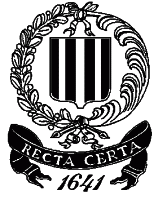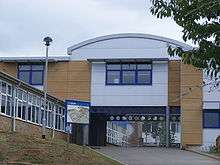The Blue School, Wells
The Blue School is a coeducational, secondary school located in Wells, Somerset, England. It had 1,570 students aged 11 to 18 of both sexes and all ability levels of which 284 were in the sixth form in 2013.[1] It is currently a Church of England voluntary controlled school. The historic school motto is "Recta Certa" which means 'straight and true'. It became an Academy in August 2011.
| The Blue School | |
|---|---|
 | |
| Address | |
Kennion Road , England | |
| Coordinates | 51.2125°N 2.6542°W |
| Information | |
| Type | Academy |
| Motto | Recta Certa (Straight and true) |
| Religious affiliation(s) | Church of England |
| Established | 1641 |
| Specialist | Science College |
| Department for Education URN | 137285 Tables |
| Ofsted | Reports |
| Head teacher | Mark Woodlock |
| Age | 11 to 18 |
| Enrolment | 1,570 in 2013[1] |
| Website | http://www.theblueschoolwells.co.uk |
An Ofsted inspection in 2007 judged the school to be 'outstanding',[2] while the next Ofsted inspection in 2010 rated the school as 'good', with outstanding elements.[3] A further Ofsted inspection was conducted throughout October 2013 again giving a rating of Good.[1] The school is a Specialist Science College and in 2006 the Princess Royal opened a new science centre.[4]
History of The Blue School

The school was founded in 1641 as one of the first free schools in the country.[5][6] The name Blue comes from the early uniforms which were blue in colour. Some visitors to Wells have expected the school itself to be blue in colour, but this is not the case.
In 1654, Margaret, widow of Ezekiel Barkham of Wells, purchased a farm in Yenston, to endow a school in Wells. The Blue School retained the farm for nearly 350 years until it was sold in 1990 and 1992.[7] The income from the endowment was to be used for paying a schoolmaster's salary of £20-0-0 pa. and the residue for apprenticing the boys when they could 'read, write and cast accounts'.[8] The school owned a number of properties in the area scattered over several parishes.[8]
Other schools were united with The Blue School foundation, including Hodge's Charity School.[8] As befitting a Church of England foundation, the Blue School has a Chaplain, plus partnership links with a school in Zambia.
The Blue School Council
The Blue School was the first pilot for an innovative approach to school councils based on self-selection called Learning to Lead[9][10] The School Community Council received praise in the School's 2007 Ofsted report.[2]
The school council runs on principles of self-election, and has over 250 members, including students of all ages and staff. Meetings are conducted during lunch times and projects include: keeping chickens, fundraising for many charities, running a garden and many more.
In 2010 two visionaries launched an ambitious project, backed by Lottery Funding, to set up a School-based radio station. The project, run by students, produced a series of podcasts. In mid 2013, after relocating, the "Blue Lounge Radio" prepared to begin to broadcast again pending the arrival of new hardware.
A charity for the benefit of the poor of St. Cuthbert's parish was established in 1675 by the will of Adrian Hickes of London, although lands in Wells and Glastonbury to endow the charity were not purchased until 1701. In 1713 a voluntary subscription school was established in Wells for boys and girls and a schoolroom was built for this purpose by Philip Hodges. He also purchased land in Glastonbury St. John, the income from which was to be used to pay the master's salary. In 1715 it was proposed that a charity established by Barkham be amalgamated with that deriving from the Hickes bequest.
Philip Hodges' will of 1723 empowered the master of the subscription school established in 1713 to teach also the pupils of Barkham's charity school. Lands in Lympsham, East Pennard and Pylle were purchased in 1732 and an estate at Norwood Park, Glastonbury in 1735. In 1740 the estates of all three charities were transferred to new trustees. Some property in Frome was acquired between 1732 and 1764 and in Queen Camel between 1730 and 1739. The charities all became part of the Blue School foundation.[8]
The current school is made up of two main blocks, Milton and Kennion which are named after the roads which they are closest to. They were built as separate schools in the 1950s and 1960s respectively but they were then joined in the 1970s. The next major change was the sports centre in 1999 which added large sporting facilities for the use of the school and the general public. Then in 2005, the school built a brand new science block.[11] More recently, in 2013, a block (named Barkham) was built, on the disused swimming pool, specifically for sixth form lessons.[12]
Alumni
- Speleologist and founder of Wells Museum Herbert E. Balch (1869–1958) won a scholarship to the school.[13]
- Filmmaker Edgar Wright was a student at the school from 1985 to 1992.[14]
- Actor Duncan Pow was a student at the school.[15]
- Scholar and humanitarian practitioner Patrick Webb was a student at the school from 1970 to 1977. He was one of the school's representatives to the Executive Committee of the Wells Civic Society in 1976/77.[16]
- Bob Kerslake, former Head of the Home Civil Service and permanent secretary at the Department for Communities and Local Government, was a student at the school.[17]
- Jasper Follas, son of Mat Follas.
References
- "2013 Inspection Report" (PDF). Oftsed. Retrieved 24 November 2015.
- "Inspection Report". Ofsted. 18 January 2007. Archived from the original on 4 September 2009. Retrieved 12 April 2010.
- "Inspection Report". Ofsted. 27 May 2010. Archived from the original on 10 January 2011. Retrieved 20 November 2010.
- "Royal start to school's new term". BBC News. 4 September 2006. Retrieved 8 December 2009.
- "Wells Blue School". National Archives. Archived from the original on 5 June 2011. Retrieved 19 March 2010.
- Davidson, Max (2 August 2008). "Town vs gown: Wells, Somerset". The Telegraph. Archived from the original on 6 November 2009. Retrieved 19 March 2010.
- 'Henstridge,' Archived 27 September 2007 at the Wayback Machine A History of the County of Somerset: Volume 7: Bruton, Horethorne and Norton Ferris Hundreds (1999), pp. 108–19, at www.british-history.ac.uk
- Archives, The National. "The Discovery Service". a2a.org.uk.
- "Home – Learn to lead". Learn to lead. Archived from the original on 6 October 2008. Retrieved 23 November 2007.
- "Research at DfE" (PDF). Archived (PDF) from the original on 30 March 2009. Retrieved 23 November 2007.
- "Facilities". theblueschoolwells.co.uk. Archived from the original on 4 October 2013. Retrieved 2 October 2013.
- "{title}" (PDF). Archived (PDF) from the original on 4 March 2016. Retrieved 27 September 2014.
- Hooper, James (7 June 1994). "To he who lit the Stygian caves". Depth through thought -OUCC News. Oxford University Cave Club. Archived from the original on 16 July 2011. Retrieved 2 May 2008.
- "Edgar Wright". MUBI Europe. Archived from the original on 27 November 2010. Retrieved 13 November 2010.
- "interview". sky1. Archived from the original on 21 November 2010. Retrieved 30 November 2010.
- "Patrick Webb". Archived from the original on 21 January 2014. Retrieved 20 October 2011.
- "Interview: A man of steel". Archived from the original on 4 April 2016. Retrieved 23 March 2016.